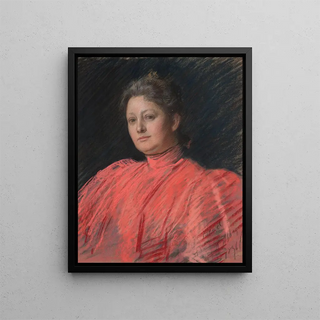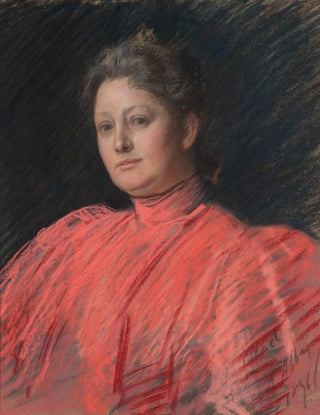Painting Portrait of Mrs. Abbey in a pink dress up to the waist - Edwin Austin Abbey


View from behind

Frame (optional)
In the fascinating world of art, some works manage to capture not only the appearance of a subject but also the very essence of their character. The "Portrait of Mrs. Abbey in a pink dress up to the waist" by Edwin Austin Abbey is one of these creations. This piece, depicting the artist's wife, stands out for its delicacy and depth of emotion that transcend a simple portrait. Through Abbey's brushstrokes, the viewer is invited to enter a universe where beauty and sensitivity meet, revealing a personal and universal story. The artwork does not merely freeze a moment; it evokes an atmosphere, a sense of timeless grace.
Style and uniqueness of the work
Edwin Austin Abbey's style is both distinctive and imbued with refined elegance. In this portrait, the shades of pink enveloping Mrs. Abbey create a captivating visual harmony, while the texture of the clothing and the fluidity of the lines demonstrate the artist's technical mastery. The meticulous details, such as the light reflections on the fabric and the pensive expression of the model, add an almost lifelike dimension to the piece. Abbey, influenced by the Pre-Raphaelite movement, manages to marry realism and idealization, offering a representation that goes beyond mere imitation. This portrait reveals not only the outer beauty of its subject but also an introspection that invites contemplation. Every gaze upon this work can evoke new emotions, making this piece a true timeless masterpiece.
The artist and his influence
Edwin Austin Abbey, born in 1852 in Philadelphia, is recognized for his exceptional talent as a painter and illustrator. His career, spanning several decades, is marked by a constant exploration of beauty and visual storytelling. Abbey established himself on the artistic scene thanks to his unique style, which combines elements of realism and symbolism. His work, often inspired by literature and history, demonstrates a keen sensitivity to human emotions. By painting his wife, he does not merely create a simple portrait; he

Matte finish

View from behind

Frame (optional)
In the fascinating world of art, some works manage to capture not only the appearance of a subject but also the very essence of their character. The "Portrait of Mrs. Abbey in a pink dress up to the waist" by Edwin Austin Abbey is one of these creations. This piece, depicting the artist's wife, stands out for its delicacy and depth of emotion that transcend a simple portrait. Through Abbey's brushstrokes, the viewer is invited to enter a universe where beauty and sensitivity meet, revealing a personal and universal story. The artwork does not merely freeze a moment; it evokes an atmosphere, a sense of timeless grace.
Style and uniqueness of the work
Edwin Austin Abbey's style is both distinctive and imbued with refined elegance. In this portrait, the shades of pink enveloping Mrs. Abbey create a captivating visual harmony, while the texture of the clothing and the fluidity of the lines demonstrate the artist's technical mastery. The meticulous details, such as the light reflections on the fabric and the pensive expression of the model, add an almost lifelike dimension to the piece. Abbey, influenced by the Pre-Raphaelite movement, manages to marry realism and idealization, offering a representation that goes beyond mere imitation. This portrait reveals not only the outer beauty of its subject but also an introspection that invites contemplation. Every gaze upon this work can evoke new emotions, making this piece a true timeless masterpiece.
The artist and his influence
Edwin Austin Abbey, born in 1852 in Philadelphia, is recognized for his exceptional talent as a painter and illustrator. His career, spanning several decades, is marked by a constant exploration of beauty and visual storytelling. Abbey established himself on the artistic scene thanks to his unique style, which combines elements of realism and symbolism. His work, often inspired by literature and history, demonstrates a keen sensitivity to human emotions. By painting his wife, he does not merely create a simple portrait; he
12,34 €






